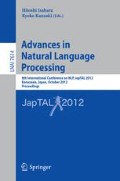Abstract
This paper presents a precision oriented example based approach for word sense disambiguation (WSD) for a reading assistant system for Japanese learners. Our WSD classifier chooses a sense associated with the most similar sentence in a dictionary only if the similarity is high enough, otherwise chooses no sense. We propose sentence similarity measures by exploiting collocations and syntactic dependency relations for a target word. The example based classifier is combined with a Robinson classifier to compensate recall. We further improve WSD performance by automatically acquiring bilingual sentences from a parallel corpus. According to the results of our experiments, the accuracy of automatically extracted sentences was 85%, while the proposed WSD method achieves 65% accuracy which is 7% higher than the baseline.
Access this chapter
Tax calculation will be finalised at checkout
Purchases are for personal use only
Preview
Unable to display preview. Download preview PDF.
References
Carpuat, M., Wu, D.: Improving statistical machine translation using word sense disambiguation. In: The 2007 Joint Conference on Empirical Methods in Natural Language Processing and Computational Natural Language Learning (EMNLP-CoNLL), Prague, Czech Republic, pp. 61–72 (2007)
Chan, Y.S., Ng, H.T.: Word sense disambiguation improves statistical machine translation. In: 45th Annual Meeting of the Association for Computational Linguistics (ACL 2007), Prague, Czech Republic, pp. 33–40 (2007)
Navigli, R.: Word sense disambiguation: A Survey. ACM Computing Surveys 41(2), 1–69 (2009)
Okumura, M., Shirai, K., Komiya, K., Yokono, H.: SemEval-2010 task: Japanese WSD. In: Proceedings of the 5th International Workshop on Semantic Evaluation, pp. 69–74 (2010)
Natural Institute for Japanese Language and Linguistics (ed.): Bunrui Goi Hyo. Dainippon Tosho (2004)
Robinson, G.: A statistical approach to the spam problem. Linux J. 2003(107) (March 2003)
Utiyama, M., Isahara, H.: Reliable measures for aligning Japanese-English news articles and sentences. In: Proceedings of the 41st Annual Meeting on Association for Computational Linguistics, ACL 2003, vol. 1, pp. 72–79 (2003)
Minnen, G., Carroll, J., Pearce, D.: Robust, applied morphological generation. In: Proceedings of the First International Natural Language Generation Conference, 201–208 (2000)
Dagan, I., Itai, A.: Word sense disambiguation using a second language monolingual corpus. Computational Linguistics 20(4), 563–596 (1994)
Lee, H.A., Kim, G.C.: Translation selection through source word sense disambiguation and target word selection. In: Proceedings of the 19th International Conference on Computational Linguistics, COLING 2002, vol. 1, pp. 1–7 (2002)
Fujii, A., Inui, K., Tokunaga, T., Tanaka, H.: Selective sampling for example-based word sense disambiguation. Computational Linguistics 24(4), 573–597 (1998)
Shirai, K., Tamagaki, T.: Word Sense Disambiguation Using Heterogeneous Language Resources. In: Su, K.-Y., Tsujii, J., Lee, J.-H., Kwong, O.Y. (eds.) IJCNLP 2004. LNCS (LNAI), vol. 3248, pp. 377–385. Springer, Heidelberg (2005)
Fujita, S., Fujino, A.: Word Sense Disambiguation by Combining Labeled Data Expansion and Semi-Supervised Learning Method. In: Proceedings of 5th International Joint Conference on Natural Language Processing, pp. 676–685 (2011)
de Melo, G., Weikum, G.: Extracting sense-disambiguated example sentences from parallel corpora. In: Proceedings of the 1st Workshop on Definition Extraction, WDE 2009, pp. 40–46 (2009)
Author information
Authors and Affiliations
Editor information
Editors and Affiliations
Rights and permissions
Copyright information
© 2012 Springer-Verlag Berlin Heidelberg
About this paper
Cite this paper
Kathuria, P., Shirai, K. (2012). Word Sense Disambiguation Based on Example Sentences in Dictionary and Automatically Acquired from Parallel Corpus. In: Isahara, H., Kanzaki, K. (eds) Advances in Natural Language Processing. JapTAL 2012. Lecture Notes in Computer Science(), vol 7614. Springer, Berlin, Heidelberg. https://doi.org/10.1007/978-3-642-33983-7_21
Download citation
DOI: https://doi.org/10.1007/978-3-642-33983-7_21
Publisher Name: Springer, Berlin, Heidelberg
Print ISBN: 978-3-642-33982-0
Online ISBN: 978-3-642-33983-7
eBook Packages: Computer ScienceComputer Science (R0)

